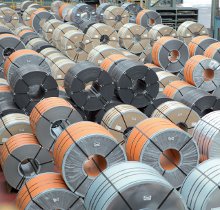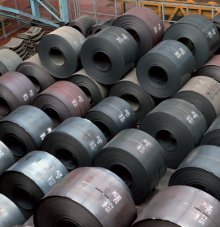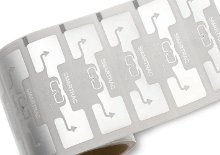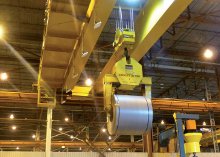Defining RFID
26 October 2012Kevin Walsh observes how developments in RFID technology have allowed it to sidestep common bugbears and potentially make it more easily applicable to the industrial lifting market.
Expected to grow by 20% on its estimated value of 5.3bn in 2011, the market for RFID solutions is certainly growing well despite the effects of the recession.
While much of the technology's popularity is owed to its popularity within the clothing sector, as RFID tags have been used to store information about, track and secure clothing for some time now, and this has been a key driver to the technology's adoption.
Within the lifting equipment sector RFID is still most commonly seen when companies need a streamlined system for inspecting cranes and ensuring compliance with LOLER regulations.
One of the latest examples of this for inspection applications is the IDBLUE.UHF reader. Designed as a pen style reader IDBLUE.UHF is small and lightweight. The specially designed tip of the reader can be used to navigate and enter data on a smartphone, instead of using your finger, an especially useful feature for application where the user is required to wear gloves.
IDBLUE CEO Steve Taylor says: "IDBLUE.UHF bridges the gap between the explosion in smartphone use and the rapid growth of RFID adoption," As companies increasingly integrate smartphones and tablets into their operations, IDBLUE turns these devices into a powerful asset tracking and management tool with a value-add RFID reader that seamlessly extends the capabilities of their smartphone infrastructure."
"The efficiencies enabled by RFID technology are more accessible than ever with our reader's cost-effective UHF design, smartphone compatibility and intuitive interface."
While stationary RFID devices are most common today, mobility is rapidly gaining market share. Similarly, Gen2 UHF hardware which represented about 14 percent of the total RFID hardware sales in 2010, is forecasted to account for almost half of the global market by 2015.
Mygrant Glass Company, one of the largest independent wholesale distributors of auto glass in the U.S., plans to deploy an IBLUE UHF reader in each of its nearly 600-strong fleet delivery vehicles nationwide after a successful initial test run.
The Hayward, California-based company will use IDBLUE readers incorporated into iPads to confirm customer deliveries and automatically update its own inventory database. The end goal is less administrative paperwork and more efficient deliveries, with the current system requiring more than 15,000 paper forms a day.
Mygrant Glass IT director Daniela Parkinson says: "IDBLUE's UHF readers save us time, money and effort all the way through the delivery process. It will also help us achieve our environmental goals by eliminating the use of thousands of cases of paper every week."
Parts tracking using RFID is also used within the lifting equipment industry, one of the more high profile companies using the solution has been UK mobile crane hire company Ainscough which uses RFID parts tracking to ensure the correct components for each particular mobile crane setup needed for specific lifts are easily located and sent together or separately to the correct site.
Although for this application it has worked very well, for other companies who have tried to use the technology it has not always worked as well. The main reason for this is when RFID technology is used in the presence of large amounts of metal, as may be found in some industrial environments, and the high number of failed reads or misreads makes the technology far less reliable.
However, in the last year tremendous progress has been made when it comes to the ability of RFID technology to work on metal and with liquids. Some companies have made great efforts to make applications where on-metal tagging is required more workable and as a result RFID-based solutions are becoming more commonly observed across industries from aerospace and automotive to medical applications, across a wide range of different sectors.
An example of this occurred just a few years ago, a manufacturer and distributor of steel coils approached automated inventory control solutions firm S.P.E.D.E Technologies about an RFID pilot project.
The coil manufacturer wanted to introduce automation into the coil picking process using an overhead crane fitted with RFID sensors on its bridge that would record the position of stored coils using x,y,z positioning. This would then allow an RFID reader mounted on the crane to identify the correct steel coil from the multitude in storage via its RFID tag before handling.
However, in a warehouse environment featuring thousands of metal coils stacked several feet high, the interference in the radio frequency signal caused by the abundance of metal in the environment meant that accurate identification proved to be impossible.
Speaking to Hoist Magazine last year, S.P.E.D.E technologies' Bob Bunsey explained: "If you have a coil bay that has different size coils, stacked at different heights you are going to get reflections. Certain things can be done to minimise any issues, but you will not get 100 per cent certainty."
While metal is known to interfere with the accuracy of a read when using Ultra-High Frequency (UHF) RFID, the level dependent on the distance the RFID reader is from the tag, the technology can be tailored with higher signal strengths, the use of High Frequency (HF) tags and shorter read distances.
But this was not acceptable for the client. Bunsey offered the firm different solutions to the problem, including lifting a picked coil above the field of interference and providing a portable reader for the crane operator to use when interference was an issue, however none was suitable for the application.
"I think it could work if you have the latitude to bring the coil to the cab, but the customer expected 100% read accuracy in an environment where you had stacks of coils, and they wanted to be able to read the tags without lifting above level of the stacks to avoid 'reflections' from other metal objects.
"We weren't able to do it in that environment. It's very possible with improved RFID readers to adjust the signal strength to limit the spurious reads but you would need the signal strength changes to be occurring in real-time."
One year on and the situation would seem to be very different.
For instance, a research team at North Dakota State University have been working on the development of an RFID tag that has no need for an antenna, which they believe would allow the tagging of metals to be done in a much cheaper way that is also much more effective than previous attempts.
Speaking on the subject, VDC Research RFID analyst Mike Liard says: "The main thing to consider here is that you are removing the antenna so you are saving that cost as part of the finished transponder, and they are mitigating RF interference issues associated with metal and liquids by removing the antenna. This technology could then be shared or licensed to vendors that may be able to produce tags in new ways and open up new markets for the technology."
Standard RFID tags consist of an integrated circuit and an antenna. Although many companies have met with some success when attempting to mitigate the degree of interference that occurs when RFID tags are with metallic surfaces, it is not too easy to find tags that perform well on metal objects. In the past, attempts to avoid this problem have focused on producing bulkier tags, however for many applications this has simply proven to be unworkable as larger tags do not always lend themselves to incorporation with the handling processes for certain applications.
Recently it has been reported that the NDSU Center for Nanoscale Science and Engineering have developed a patent-pending approach, where an antenna less RFID tag allows for an inexpensive product tracking solution that meets EPCglobal standards.
"Most RFID tags that are to be used on metal objects are made by placing an antenna on a spacer, making them between 0.5 and 3 cm thick, depending on the type of tag," says Cherish Bauer-Reich, a research engineer on the NDSU team. "Such tags can be easily damaged because they stick out so far. The tags developed by NDSU CNSE are less than 3 mm thick and are placed directly on the metal, or could be recessed into the surface of a metal container."
For this method the metal container itself is used as the antenna, rather than having to make and place another antenna on top of the container.
"We were working on some other projects that involved trying to put tags on metal containers and through this research discovered that previous research overlooked an obvious source of the antenna, which is the container," says Bauer-Reich. "So we came up with the idea of utilising the container instead of working against it."
While for many applications many types of RFID tag have to be kept away from metal elements to prevent excessive warping of the electromagnetic fields around the tags, rendering them incapable of sending or receiving signals, these newly developed tags use the metal container as the antenna to transmit information. Because of this unique property, the tags can be used to tag anything from coffee cans at a grocery store to barrels of oil or metal cargo containers, with minimal concern about losing or damaging the tag.
North Dakota State University's associate director for electronics technology at its Center for Nanoscale Science and Engineering (CNSE), Aaron Reinholz, says that there are a number of large niche markets where antenna less tags could be useful. He cites the oil and gas industry, and attaching tags to metal pipes and other drilling equipment used in the mining industry. IT asset tracking, which has gained a strong foothold with UHF tags, could be another market for the new tags.
"Anything with a metal case would be ideal," says Reinholz, "including instrumentation tools or tracking of smaller cargo containers. If it could be generated cheap enough, it's possible to go down to the item level and start tagging things like coffee cans."
Before the new technology can be commercialized, it will likely have to become even smaller than the current form factor. The NDSU research team has set its hopes on altering the technology enough to the point where it can become a paper thin and embedded on containers. In addition, changes in design will make the tags effective for more applications.
"Right now the substrate material is rigid, and it would improve the market potential if we could move forward with more of flexible substrate," says Reinholz. "In order to make it work better and use it on a lot more materials, we'd like to make it flexible and very thin."
The staff at NDSU is in the early stages of contacting potential partners to help commercialize the tags. Since the NDSU is a state-funded research center, it does not have a manufacturing facility. The likely options include licensing the technology to an RFID vendor, or accepting a sponsored research agreement that benefits the research team.
One thing is certain. The antenna less tags will remain a niche solution for on-metal applications where it makes sense. They likely won't be used for tagging boxes in typical inventory management solutions. Reinholz says it's still too early to determine tag pricing.
"I don't think these tags will ever be able compete with commodity tags from places like Avery Dennison or Alien," he says. "The material costs there are quite a bit lower than I think we could ever be able to get to with these tags, just because we're probably going to have some other unique materials that may not be as cheap as nylon, for example."
Steely determination
In terms of lifting applications, one application for RFID that has been frequently looked at is the picking and handling of steel coils, a job that many companies can immediately see the benefit of automating to some degree. Posco, one of the largest steelmakers in Korea, deployed an RFID-based logistics system to streamline critical operational processes while providing its customers with real-time product information and simultaneously improving packaging and shipping accuracy.
The company manufactures metal products, each easily weighing several tons, in large quantities. Any streamlining of their logistical systems needed to be reliable and speedy and RFID seemed to fit the bill.
But before any RFID system could be implemented they would need to overcome the interference problem that has dogged systems integrators using RFID for years now. And in an environment where there would be a struggle to find an area of their operations that wasn't subject to high levels of electromagnetic interference this was not going to be easy.
The company brought in UPM RFID, which has since become part of Dutch technology firm Smartrac. Specialising in the supply and manufacture of RFID solutions, UPM RFID designed an RFID-based logistics system that utilised modified versions of the company's own DogBone UHF RFID tags, along with handheld industrial PDAs, fixed RFID readers attached to the cranes and placed at factory gates.
For this application manufactured metal coils were tagged with custom DogBone tags that have two antennas and then placed inside the heavy metal coils. Placing them on the coils in a position where the RFID tags were perpendicular to the items' curved surface dramatically reduced the level of interference experienced during reading of the tags. This allowed the operator of the crane, which was fitted with an RFID reader, to identify and pick specific coils from a storage area filled with metal coils.
Each item is tagged during packaging and can be read when moved to the warehouse and during storage as well as during final packaging for shipment.
Smartrac claims that applying the RFID solution as a 'flag tag', where the tag is standing upright, ensures their readability while the DogBone tags -- for which the integrated circuit is incorporated into a paper medium -- results in a cost-effective solution for such a for large-scale inventory deployment. Tracking more than two million steel components produced by the company each year, Posco began the process with a pilot to identify coil products manufactured at its Kwangyang and Pohang plants in Korea for a small group of 17 customers. The solution has worked so well for Posco that the company has since begun to tag all of its products using the system, which at any one time could be more than two million components.
By implementing the RFID-based logistics system, Posco has automated the inspection, packaging and shipping of its metal coil products, eliminating errors that occurred previously with manual processes. Meanwhile, customers are able to instantly access real-time data on the product's movements, enabling them to forward plan their own production operations based on the components supply chain movements. UPM RFID also supplied enterprise resource management software to help customers achieve this and manage the process of integrating the RFID system easily with their own planning solutions.
By providing easy access to better data, as well as more accurate shipments, Posco claims that the benefit to customers has been easily identifiable.
In this case, return on investment might be the reason for such a quick ramp-up. Posco says that the solution has reduced costs by USD 1.4 million per month, resulting in a savings of almost USD 17 million a year.
By implementing the RFID-based logistics system, Posco has automated the inspection, packaging and shipping of its metal coil products. In addition to providing complete traceability of company products, the RFID system has decreased packaging and shipping errors.
The other interesting aspect is that the automated RFID-based solution, which is designed to improve the accuracy and efficiency of key operational processes, is being backed by funding from the Korean government as part of the nation's drive to become a leader in the field of ubiquitous sensor networks.
The Korean government has already jump-started RFID tagging in the pharmaceutical industry by mandating that 50 percent of the drugs sold in Korea carry RFID tags within five years.



